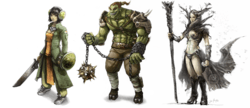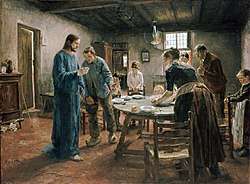Contemporary fantasy
Contemporary fantasy, also known as modern fantasy or indigenous fantasy, is a subgenre of fantasy, set in the present day or, more accurately, the time period of the maker. It is perhaps most popular for its subgenre, urban fantasy.
| Fantasy |
|---|
 |
| Media |
|
| Genre studies |
| Subgenres |
|
| Fandom |
| Categories |
|
|
Strictly, supernatural fiction can be said to be part of contemporary fantasy - since it has fantasy elements and is set in a contemporary setting. In practice, however, supernatural fiction is a well-established genre in its own right, with its own distinctive conventions.
Definition and overview

These terms are used to describe stories set in the putative real world (often referred to as consensus reality) in contemporary times, in which magic and magical creatures exist but are not commonly seen or understood as such, either living in the interstices of our world or leaking over from alternate worlds. It thus has much in common with, and sometimes overlaps with secret history; a work of fantasy in which the magic could not remain secret, or does not have any known relationship to known history, would not fit into this subgenre.
Novels in which modern characters travel into alternative worlds, and all the magical action takes place there (except for the portal required to transport them), are not considered contemporary fantasy. Thus, C.S. Lewis's The Lion, the Witch and the Wardrobe, where all fantasy events take place in the land of Narnia which is reached via a magic wardrobe, would not count as contemporary fantasy; on the other hand, the part of The Magician's Nephew, where the Empress Jadis gets to London, tries to take over the Earth and clashes with police and a crowd of cockneys, would qualify as such.
Contemporary fantasy is generally distinguished from horror fiction – which also often has contemporary settings and fantastic elements – by the overall tone, emphasizing joy or wonder rather than fear or dread.
In his preface to That Hideous Strength, one of the earlier works falling within this subgenre, C.S. Lewis explained why, when writing a tale about "magicians, devils, pantomime animals and planetary angels", he chose to start it with a detailed depiction of narrow-minded academic politics at a provincial English university and the schemes of crooked real estate developers: "I am following the traditional fairy-tale. We do not always notice its method, because the cottages, castles, woodcutters and petty kings with which a fairy tale opens have become for us as remote as the witches and ogres to which it proceeds. But they were not remote at all to the men who first made and enjoyed the tales".[1] The same is true for many of the later works in the genre, which often begin with a seemingly normal scene of modern daily life to then disclose supernatural and magical beings and events hidden behind the scenes.
Subgenres
Contemporary fantasies often concern places dear to their authors, are full of local color and atmosphere, and attempt to lend a sense of magic to those places, particularly when the subgenre overlaps with mythic fiction.
When the story takes place in a city, the work is often called urban fantasy.
The contemporary fantasy and low fantasy genres can overlap as both are defined as being set in the real world. There are differences, however. Low fantasies are set in the real world but not necessarily in the modern age, in which case they would not be contemporary fantasy. Contemporary fantasies are set in the real world but may also include distinct fantasy settings within it, such as the Harry Potter series, in which case they would be high rather than low fantasy.
Examples
19th and early 20th centuries
- Erich Kästner The 35th of May, or Conrad's Ride to the South Seas
- Robert Louis Stevenson: The Bottle Imp
- Jack Williamson: Darker Than You Think
- William T. Cox, Fearsome Creatures of the Lumberwoods
- Denis Wheatley's Gregory Sallust series, pitting the protagonist against supernatural forces on the background of WWII and Nazi Germany.
- Stella Benson: Living Alone
- Edith Nesbit: The Magic City, Psammead series, House of Arden series, The Enchanted Castle, The Magic World and other works
- Edward Eager: The Magic Series
- P. L. Travers: Mary Poppins
- Mikhail Bulgakov: The Master and Margarita
- Rudyard Kipling, Puck of Pook's Hill
- C.S.Lewis: That Hideous Strength
- Hendrik Willem van Loon: Van Loon's Lives
- Selma Lagerlöf: The Wonderful Adventures of Nils (orig. Nils Holgerssons underbara resa genom Sverige)
- H. G. Wells: The Wonderful Visit, The Sea Lady and The Man Who Could Work Miracles
- Charles Williams: An early innovator of theology-oriented contemporary fantasy.
Later 20th and early 21st centuries
- Freda Warrington's Aetherial Tales series
- Benedict Jacka's Alex Verus series
- Eoin Colfer's Artemis Fowl series
- Ryohgo Narita's Baccano! (in part) and Durarara!!
- Tite Kubo's Bleach
- Mary Norton's The Borrowers
- Joss Whedon's Buffyverse
- Kazuma Kamachi's A Certain Magical Index
- Virtually the entire oeuvre of Charles de Lint
- Dangerous Angels and other works by Francesca Lia Block
- Constance M. Burge's Charmed
- Dark Cities Underground by Lisa Goldstein
- Susan Cooper's The Dark Is Rising Sequence
- Tom Deitz's The David Sullivan series
- Hazel Butler's Deathly Insanity series.
- Jenna Black's The Devil Inside, set in the United States with demons.
- The Dresden Files series by Jim Butcher
- Raymond E. Feist's Faerie Tale
- Type-Moon's The Garden of Sinners, Tsukihime, and Fate series which takes place in a world where magic has all but vanished as technology has overtaken it and all the gods and magical creatures have either disappeared or simply left.
- Peter S. Beagle's A Fine and Private Place and other works by him.
- Richelle Mead's Georgina Kincaid series
- Midori Snyder's Hannah's Garden
- J.K. Rowling's Harry Potter series - set in the United Kingdom during the 1990s, with flashbacks to the 1920s, 1930s, 1940s, 1970s, and 1980s, and flash-forwards to the 2010s. Harry Potter and the Cursed Child is set during the 2020s, with flashbacks to the 1980s, 1990s, and 2010s. Alternately, J.K. Rowling's Fantastic Beasts series of screenplays, takes place in a number of global locations, throughout the 1920s, '30s, and ending in 1945.
- Kouta Hirano's Hellsing
- Philip Pullman's His Dark Materials trilogy - The trilogy takes place across several universes including "ours".
- Hirohiko Araki's JoJo's Bizarre Adventure (Stardust Crusaders, Diamond Is Unbreakable, Golden Wind, Stone Ocean, and JoJolion)
- China Miéville's King Rat
- Little, Big and other works by John Crowley
- Lev Grossman's The Magicians series
- Various works by Mercedes Lackey.
- Minions of the Moon by Richard Bowes
- Boris and Arkady Strugatsky's "Monday Begins on Saturday", where magic and characters from Russian myth exist in the Soviet Union of the time of writing.
- Nisio Isin's Monogatari series.
- A number of works by Neil Gaiman, among them American Gods and Neverwhere, set in a secondary world below London with links to the real world.
- Sergei Lukyanenko's Night Watch, set in Moscow. It has three sequels that form a tetralogy; Day Watch, Twilight Watch and Final Watch.
- Natasha Mostert's The Other Side of Silence and Season of the Witch
- Rick Riordan's Percy Jackson & the Olympians, Heroes of Olympus, The Kane Chronicles, Magnus Chase and the Gods of Asgard, and The Trials of Apollo series.
- Richard Kadrey's Sandman Slim series
- Derek Landy's Skulduggery Pleasant (series)
- Josepha Sherman's Son of Darkness
- Charlaine Harris' The Southern Vampire Mysteries and its television adaption, True Blood
- Eric Kripke's Supernatural
- Various works by Tanya Huff.
- Most of the novels of Tim Powers
- Tithe: A Modern Faerie Tale and a number of other works by Holly Black
- Sui Ishida's Tokyo Ghoul
- Stephenie Meyer's Twilight Saga
- Isaac Asimov's "The Two-Centimeter Demon" and other stories involving the tiny demon Azazel.
- L.J. Smith's The Vampire Diaries (novel series) and its television adaption
- P.N. Elrod's Vampire Files series following Jack Fleming a vampire P.I.
- Emma Bull's War for the Oaks
- Clive Barker's Weaveworld and Imajica
- Tony Vilgotsky's Chronicles of Skharn and Shepherd of the Dead
- W.I.T.C.H. a comic series by Elisabetta Gnone, Alessandro Barbucci, and Barbara Canepa.
- Kelley Armstrong's Women of the Otherworld series
- Terri Windling's The Wood Wife
- Terry Brooks' Word/Void novels
- Diane Duane's Young Wizards - the protagonists live in Manhattan, New York, but each book in the series has a different setting; settings include various planets within and outside of the Solar System and various alternative universes.
- Ysabel by Guy Gavriel Kay mostly set in 21st-century Aix-en-Provence
- Yoshihiro Togashi's Yu Yu Hakusho
- P. B. Kerr' Children of the Lamp
- Oh Seong-dae's Tales of the Unusual
Overlap with other genres
Contemporary fantasy can also be found marketed as mainstream or literary fiction and frequently marketed as magical realism, itself arguably a fantasy genre. Examples include Practical Magic by Alice Hoffman, The Antelope Wife[2] by Louise Erdrich, and Mistress of Spices by Chitra Bannerjee Divakaruni.
See also
References
- Lewis, C.S. "That Hideous Strength". Google Books. Simon and Schuster. Retrieved 15 October 2017.
- Kakutani, Michikomi. "'Antelope Wife': Myths of Redemption Amid a Legacy of Loss". Books of the Times. The New York Times Company. Retrieved 16 October 2017.
- Martin Horstkotte, The postmodern fantastic in contemporary British fiction. WVT, Trier 2004, ISBN 3-88476-679-1
- Lance Olsen, Ellipse of uncertainty : an introduction to postmodern fantasy. Greenwood Press, Westport 1987, ISBN 0-313-25511-3